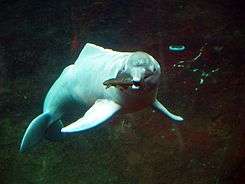Iniidae
Iniidae is a family of river dolphins containing one living genus, Inia, and four extinct genera. The extant genus inhabits the river basins of South America, but the family formerly had a wider presence across the Atlantic Ocean.
| Iniidae | |
|---|---|
 | |
| An Amazon river dolphin at Duisburg Zoo | |
 | |
| Size compared to an average human | |
| Scientific classification | |
| Kingdom: | Animalia |
| Phylum: | Chordata |
| Class: | Mammalia |
| Order: | Artiodactyla |
| Infraorder: | Cetacea |
| Superfamily: | Inioidea |
| Family: | Iniidae Gray, 1846 |
| Genera | |
|
See text | |
Iniidae are highly morphologically different from marine dolphins by way of adaptations suited to their freshwater riverine habitat.[1] They also display a high amount of sexual dimorphism in the form of color and size.[2] Seasonal movement between flooded plains and rivers is common, due to the variation of seasonal rain.[3] There has been little research done on the family, in particular the species aside from the Amazon river dolphin.[2]
Evolution
The South American river basins were flooded by marine waters, creating a new brackish habitat that allowed marine mammals to move into them. During the Miocene era, the sea level began to recede, trapping the mammals within the continent.[1]
Morphology
The Iniidae have adapted morphology common to freshwater riverine habitats.[4] These adaptions include cervical vertebra that are not fused, allowing for a flexible neck. Also, their dorsal fins are highly reduced or absent so they do not become entangled in vegetation from the flooded terrestrial plains. Large, wide, paddle-like pectoral fins allow for maneuverability in small vegetated areas.[5] Other riverine adaptations including a long rostrum, skull and jaw and reduced orbits.[6]
Iniidae have many characteristics common to their marine odontocete relatives. Their stomachs include a fore-stomach, singled chambered main stomach and a pyloric stomach with connecting channels. Also, Iniidae have lost their fur and lack true vocal cords.[7] They share the similar structure of the tympanic bulla and lung shape, the position of their diaphragm and the position of the blowhole to the back of the head with their marine ancestors.
The dentition of Iniidae dolphins is heterodont, having conical, small teeth. The teeth extend lingually in the back and in the front they have a small depression on the side of each. These mammals are carnivorous, finding prey by using echolocation.
Speciation
There is a debate on the number of species within the genus Inia. The main debate is whether there are two or three species and whether they can be considered sub-species. Inia geoffrensis, Inia humboldtiana and Inia boliviensis, according to certain scientists, are considered three separate species, while many consider I.geoffrensis and I. boliviensis to be the only two.[8][9][3] Martin in 2004 founded supporting evidence that genetic exchange between multiple sites of the Amazon, even ones hundreds of kilometres away, is possible.
Taxonomy
The family was described by John Edward Gray in 1846.[10]
Current classifications include a single living genera, Inia, with one to three[11] species and several subspecies. The family also includes three extinct genera described from fossils found in South America, Florida, Libya, and Italy.[10]
- Superfamily Inioidea
- Family Iniidae
- Genus †Goniodelphis
- G. hudsoni
- Genus Inia
- Inia araguaiaensis - Araguaian river dolphin
- Inia boliviensis - Bolivian river dolphin
- Inia geoffrensis - Amazon river dolphin
- I. g. geoffrensis - Amazonian river dolphin
- I. g. humboldtiana - Humboldt River dolphin
- Genus †Isthminia
- †Isthminia panamensis
- Genus †Meherrinia
- Genus †Ischyrorhynchus (syn. Anisodelphis)
- I. vanbenedeni (syn. Anisodelphis brevirostratus)
- Genus †Saurocetes (syn. Saurodelphis, Pontoplanodes)
- S. argentinus (syn. Pontoplanodes obliquus)
- S. gigas
- Genus †Goniodelphis
- Family Iniidae
References
- Hamilton, Healy, et al. "Evolution of river dolphins." Proceedings of the Royal Society of London B: Biological Sciences 268.1466 (2001): 549-556.
- Martin, A. R., & Silva, V. M. (2006). Sexual Dimorphism And Body Scarring In The Boto (Amazon River Dolphin) Inia Geoffrensis. Marine Mammal Science,22(1), 25–33. doi:10.1111/j.1748-7692.2006.00003.x
- Rice, Dale W. "Marine mammals of the world, systematics and distribution." Society for Marine Mammalogy Special Publication 4 (1998): 1-231.
- Gutstien, Carolina (2014). "The Antiquity of Riverine Adaptations in Iniidae (Cetacea, Odontoceti) Documented by a Humerus from the Late Miocene of the Ituzaingo Formation, Argentina". The Anatomical Record. 297 (6): 1096–1102. doi:10.1002/ar.22901. PMID 24585575.
- Gomez-Salazar, C. (2011). Photo-Identification: A Reliable and Noninvasive Tool for Studying Pink River Dolphins (Inia geoffrensis). Aquatic Mammals,37(4), 472–485. doi:10.1578/am.37.4.2011.472
- Pyenson, Nicholas D., et al. “Isthminia Panamensis, a New Fossil Inioid (Mammalia, Cetacea) from the Chagres Formation of Panama and the Evolution of 'River Dolphins' in the Americas.” PeerJ, PeerJ Inc., 1 Sept. 2015, peerj.com/articles/1227/.
- Kaiya, Zhou. "Classification and phylogeny of the Superfamily Platanistoidea, with notes on evidence of the monophyly of the Cetacea." Sci. Rep. Whale Res. Inst 34 (1982): 93–108.
- Gravena, Waleska, et al. "Looking to the past and the future: were the Madeira River rapids a geographical barrier to the boto (Cetacea: Iniidae)?." Conservation Genetics 15.3 (2014): 619–629.
- Ruiz-García, M., Banguera, E., & Cardenas, H. (2006). Morphological analysis of three Inia (Cetacea: Iniidae) populations from Colombia and Bolivia. Acta Theriologica, 51(4), 411–426. doi:10.1007/bf03195188
- The paleobiology Database
- Hrbek, Tomas; Da Silva, Vera Maria Ferreira; Dutra, Nicole; Gravena, Waleska; Martin, Anthony R.; Farias, Izeni Pires (2014-01-22). Turvey, Samuel T. (ed.). "A New Species of River Dolphin from Brazil or: How Little Do We Know Our Biodiversity". PLOS ONE. 9 (1): e83623. Bibcode:2014PLoSO...983623H. doi:10.1371/journal.pone.0083623. PMC 3898917. PMID 24465386.
External links
| Wikimedia Commons has media related to Iniidae. |
| Wikispecies has information related to Iniidae |